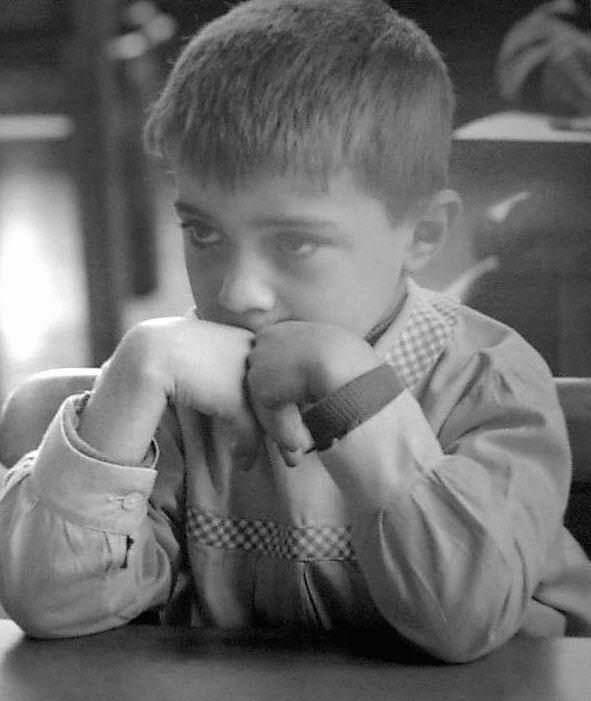
French School Smocks--Individual Boy

Figure 1.--This French school boy was photographed in 1952 by famed French photographer Doisneau. He wears a light colored back-buttoning smock (tablier) with gigham detaling at the front above the pleating and around the collar. Ginham was presumably chosen nevause it was a popular material for smocks and somed smocks were done in gingam, usually red or blue. This boy looks to be 9-10 years old.
|
An European reader has provided some comments on the photograph and smock pictured here. He writes, "What a marvellous photography by Doisneau, and what a pity that
the most famed French phothograper (should we not say poet?) did not take the photograph so as to display full smock. So we have to guess about the photograph and what the smock was like. Is the boy really in a classroom, captivated by the teacher - or is he not
elsewhere dreaming of a better world (out of school)? I also wonder about the detailing. The boy's smock is not the regular French school smock type: plain colour either grey, dark blue or black. So I guess the boy's mother was a real loving mother (most are) who
wanted his son to be just a bit different, and may have sewed the smock hefself. Interesting that the gingham detailing was not used to trim the cuffs (wrist) which usually would be the case. I guess also that the pocket was not entirely made out of gingham, but had just a stripe on the upper part. This is how the collar was done. It is not made of, but adorned with gingham trim--an unusual method. Still guessing, the waist band was entirely of gingham, closed in the back with a knot."
An European reader has provided some comments on the photograph and smock pictured here. He writes, "What a marvellous photography by Robert Doisneau." It is one of many images of everyday French life left us by the famed photographer.
The Smock
A reader writes, "What a pity that the most famed French phothograper (should we not say poet?) did not take the photograph so as to display full smock. So we have to guess about the photograph and what the smock was like. I also wonder about the detailing. The boy's smock is not the regular French school smock type: plain colour either grey, dark blue or black. So I guess the boy's mother was a real loving mother (most are) who
wanted his son to be just a bit different, and may have sewed the smock hefself. Interesting that the gingham detailing was not used to trim the cuffs (wrist) which usually would be the case. I guess also that the pocket was not entirely made out of gingham, but had just a stripe on the upper part. This is how the collar was done. It is not made of, but adorned with gingham trim--an unusual method. Still guessing, the waist band was entirely of gingham, closed in the back with a knot."
The Boy
A reader is captivated by the imafe. He asks, "Is the boy really in a classroom, captivated by the teacher - or is he not elsewhere freaming of a better world (out of school)?
A French reader is drawn back to his boyhood and the innosence relected in Doisneau's photograph. He writes, "Beautiful comment about this boy who is daydreaming in school. I am shure his dream was pure and innocent. At the time there was no television. We never even imagined some of the things that children today are exposed to daily. Many swear words were unnkown of us. I perfectly recall that at age 11 I did not have the slighest idea as to where babies came from and I was not unusual in this regard. It was excatly the same
thing for the others boys. We French children were told girls came from a rose and boys from a cabbage! It was just the same in Austria where I lived for a time. In the "Ecole laïque" the teachers addressed the schoolchildren saying "tu" and in the private or more in the catholic schools the teachers used "vous = you" for children. In France the use of "tu or vous " is codified and must to be respected. The very young children say only "tu" for everybody which gives them a touch of innocence. My grandson still says "tu" to everybody, but soon he will have to use the more respectful form. For instance, Tu vas à l'école = you are going to the school (adressed to a child) .
Vous allez à l'école = (adressed to a adult or sometime to a child).
Christopher Wagner

Navigate the Boys' Historical Clothing smock pages
[Return to the Main French school smock page]
[Return to the Main smock page]
[Main school smock page]
[French school smocks]
Navigate the Boys' Historical Clothing French pages
[Return to the Main French page]
[French school uniforms]
[French royalty]
[French scouts]
[French choirs]
[French movies]
[French catalogs]
Related Style Pages in the Boys' Historical Web Site
[Smocks]
[Caps and berets]
[Long pants suits]
[Shortpants suits]
[Socks]
[Eton suits]
[Jacket and trousers]
[Blazer]
[School sandals]
Navigate the Boys' Historical Clothing School Uniform Pages
[Main School Uniform Page]
[Australia]
[England]
[Main French school page]
[Germany]
[Italy]
[Japan]
[New Zealand]
[Scotland]
[United States]
Navigate the Boys' Historical Clothing Web Page
[Introduction]
[Activities]
[Bibliographies]
[Biographies]
[Chronology]
[Clothing styles]
[Countries]
[Contributions]
[FAQs]
[French glossary]
[Satellite sites]
[Boys'Clothing Home]
Created:January 2, 2002
Last updated: January 2, 2002



